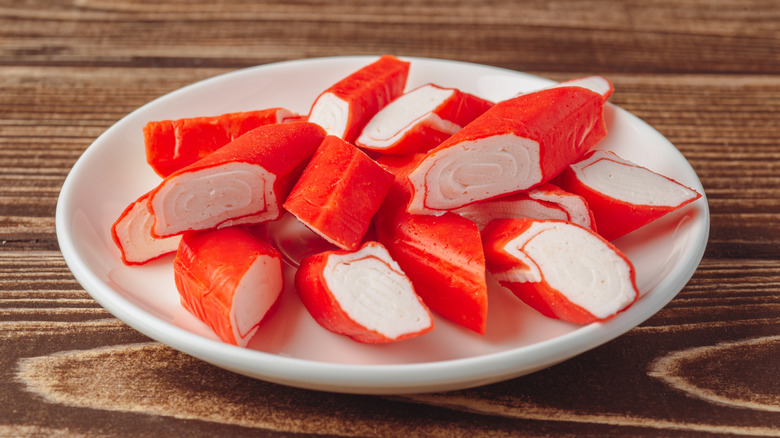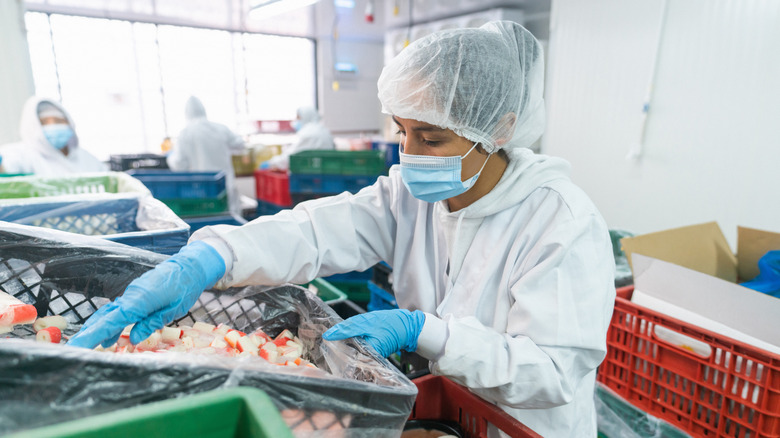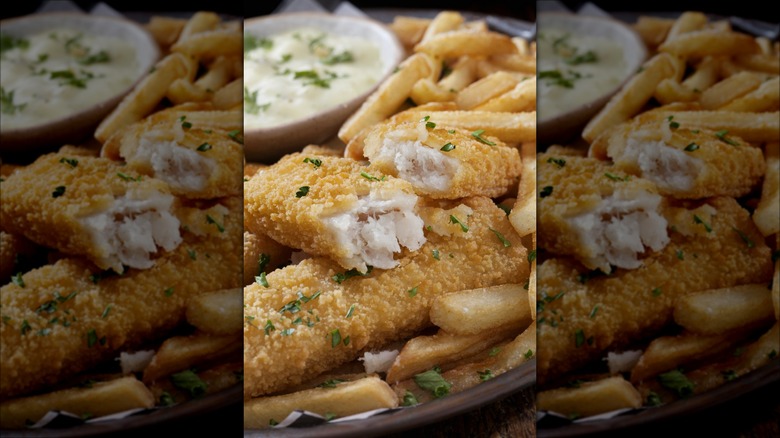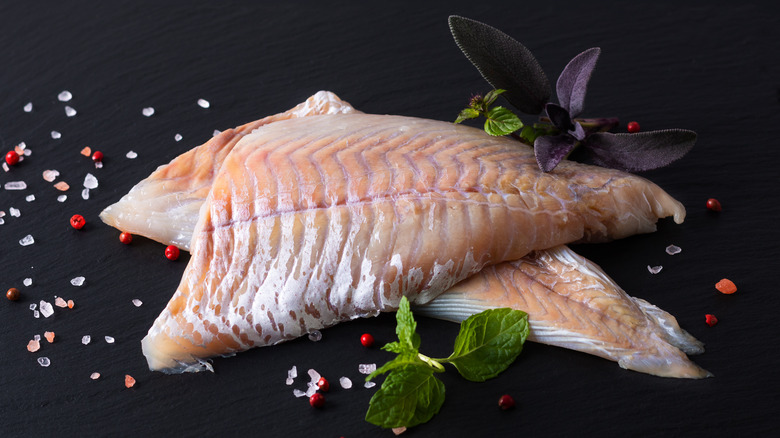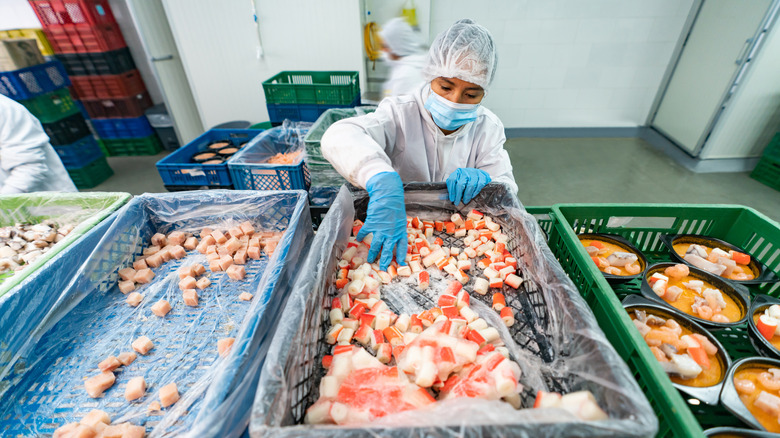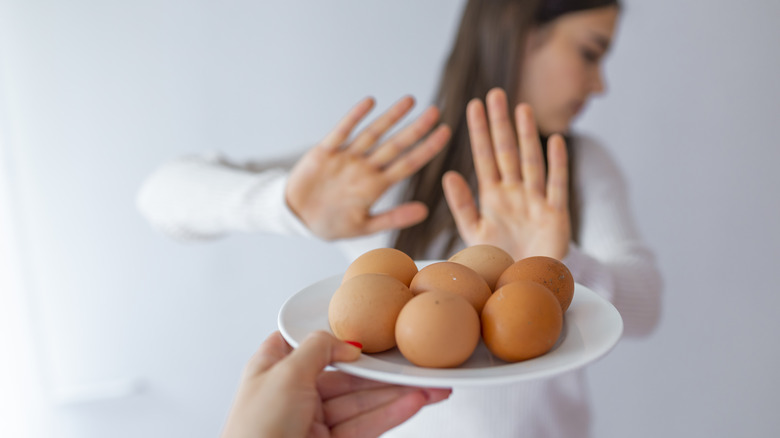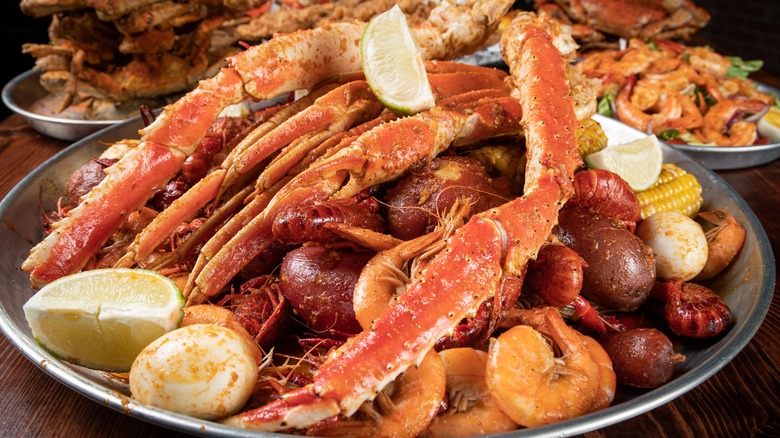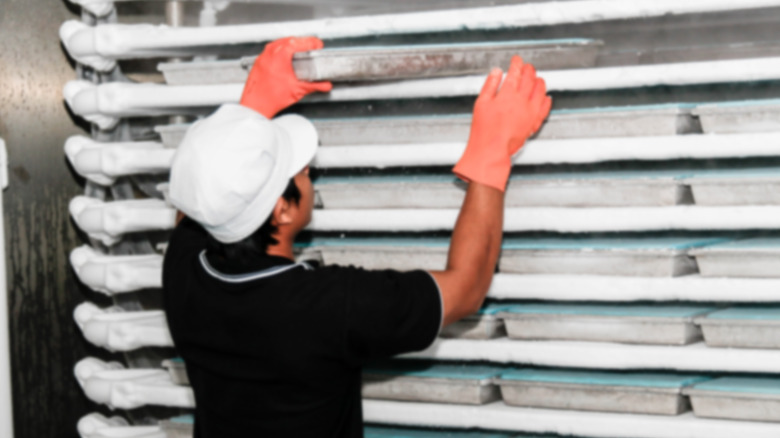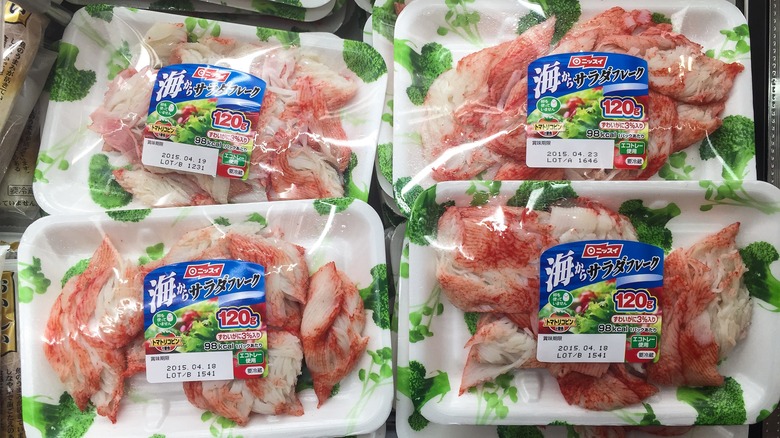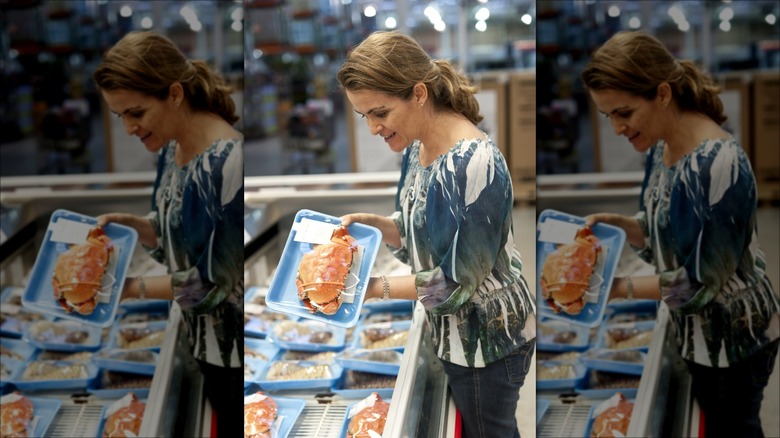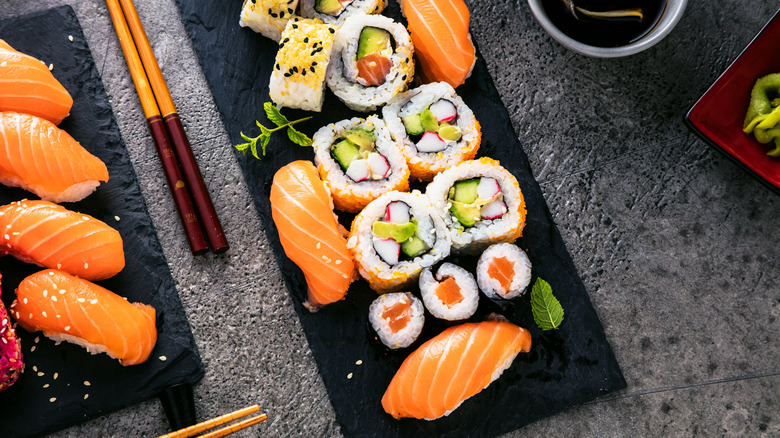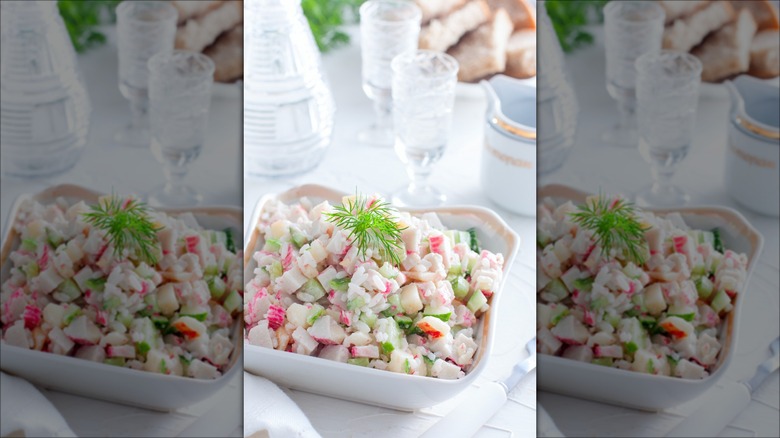What Exactly Is Imitation Crab Meat And How Do You Cook With It?
You don't buy imitation crab, you say? You're certain you've never eaten it? Perhaps, but truthfully, probably this isn't the case. Maybe you didn't eat it on purpose, but given the ubiquity of faux crab, it's likely that some of it has rolled over your taste buds at one time or another, whether you realized it or not. The crab rolls at the sushi restaurant, the to-die-for crab rangoon in the store's freezer section, and your friend's seafood chowder recipe probably all contained it.
And while the thought of eating faux crab might not excite you, it's not as faux as you think. While it's not a full-blown serving of king crab legs, it is fully seafood, made from some pretty common fish. Some versions of it even contain as much as 50% real crab extract, making it harder and harder to tell real from faux. Not all imitation crab contains that much of the real stuff, but all of the different brands on the market usually contain some real crab extract. Something has to give it its crabby flavor, after all.
Aside from all of this, its cheaper-than-the-real-stuff price puts seafood back on the table for those who either can't afford real crab or who just want to save a buck while still enjoying the flavor of this popular crustacean without breaking the bank. In this piece, we take a deep dive into faux crab, how it's made, the many names it goes by, and more.
The proper name for it is surimi
Imitation crab is literally fish by another name, and over time, it has proven to be just as sweet on the taste buds of the common seafood eater as its real-life crab counterpart. Called "surimi" in the seafood industry, it's all just one mound of fish paste that gets pressed into the shape of crab legs and colored pretty in pink to look like the shellfish it wishes to impersonate. And for most people, it does a pretty good job impersonating crab, right down to looking a lot like the real thing.
The process of turning surimi into imitation crab comes down to deboning it and washing it to remove bits of unwanted fat and other not-so-edibles before the manufacturer minces it into fish paste. As mentioned, the only actual crab in it typically comes from extract, which gives the faux crustacean its crabby flavor. It helps that the fish types that become surimi fish paste come with both a mild taste and smell, allowing them to better submerge themselves into their new role as the crab in your crab cakes.
Japanese chefs have made a version of it for over 900 years
When Anthony Bourdain told people not to order the fish special on Mondays in his book "Kitchen Confidential," he highlighted the very real issue of fish going bad before professional restaurant chefs can get the fish they bought on Friday all cooked and sold before Monday. However, the practice of chefs running specials, like the Monday fish, to salvage that expensive piece of fish pre-dates Bourdain by nearly a thousand years.
It happened in Japan, where Japanese chefs turned their leftover fish waste into surimi. They began doing it 900 years ago or so. While the stuff it was made from back then might be considered waste today, for those chefs, it was a delicacy. All they needed was a bit of salt in which to immerse the fish bits. Once its salt bath drew to a close, those ancient Japanese chefs ground the fish into a gel and put it on the table for dinner.
It should probably come as no surprise, then, that it was a Japanese chemist who figured out how to tap into sugar's preserving powers — instead of salt's — to make the first modern version of surimi. The modern surimi industry leaped out of the ancient world and into the modern one with that one invention. While it still counts as a big industry in Japan, the surimi industry — and the faux crab it produces — exists all over the world, including in the U.S.
Surimi is used in a number of faux seafood types
Surimi is ubiquitous and sneaky, as it turns out. It goes beyond just being the base for the faux crab on Subway's crab sandwich. If you've ever chowed on some good ol' crunchy fish sticks or fish patties at your favorite lunchtime haunt, you've experienced the flexibility of surimi firsthand. And imitation lobster shouldn't be forgotten, either. That's right — it's the result of surimi being made to look and taste like another crustacean aside from crab.
In fact, in Japan, you see it pretty much everywhere, in products like kamoboko (hot pink- and white-colored fish cakes), hanpen (fish squares), and chikuwa (tube-shaped fish products). Although pollock is often used to make the surimi that becomes imitation crab meat, food nerds may appreciate knowing that sardines also become surimi in some instances. It's additionally worth mentioning that not all surimi comes from processed fish parts. Surimi just means "ground meat" in Japanese. As such, a trip down the grocery store aisle may also include products made from chicken surimi and other ground meat.
Usually, imitation crab comes from Alaska pollock
Surimi, the fish paste from whence faux crab is made, usually consists of pollock fish, but it's not limited to that. Manufacturers might use Pacific whiting to make it too. Tilapia and cod also get tapped for the job on occasion. In China, carp morph into surimi. Even the fish that make up that popular kippered snack, sardines, have become surimi in Japan. This type of surimi often becomes fish balls instead of imitation crab. Although sardines don't have quite the fishy taste that, say, anchovies do, their taste is still decidedly fishy. For surimi to work as intended, the fish it gets made from must be mild in flavor to allow it to taste like a crustacean and not a scaly fish.
The fish that become surimi typically come from fish farms. Many have been chosen as the basis for surimi because they offer less value as a seafood dinner for fish lovers than other types of fish. Raising them is an economical way to use up fish that might not otherwise be eaten.
How is imitation crab made?
Before imitation crab can become the faux crab its fans love so much, the fish parts-turned-surimi it's made from must undergo a somewhat lengthy process. The fish first gets shredded up or mashed up into a paste. This mixture gets heated up, and eventually, the paste gets molded into a product that looks like crab leg meat. To keep all of this pulled together, the manufacturer introduces binding agents. Sugar, egg whites, vegetables, or starch may be called upon to do the trick. Of course, without the food dye to make it look bright crabby red or orange, it would just look like fish cakes minus the crunchy coating. Monosodium glutamate also gets tossed in on occasion. When you buy it in the store, it's these colors and shapes that make it look like shellfish from inside the vacuum-packed package.
If all of this processing makes faux crab and the surimi it comes from sound a lot like the ballpark franks you so love, you aren't off the mark. Surimi processing has earned it the nickname the "hot dog of the sea," per Alaska Public Media. It's a fitting nickname given that Tyre Lanier, a food scientist at North Carolina State University and purveyor of surimi in the U.S., learned to appreciate the flexibility of surimi as a base for faux crabby cakes when he tried to make actual hot dogs from fish parts.
Who can't eat it?
For people who are inclined to rejoice at all things crab, faux crab equals an invention that has saved economical seafood dinners everywhere. However, not everyone rushes to get their share of crab sushi made with imitation crab. This includes those who have allergies to ingredients like eggs and shellfish. For them, faux crab is a decided no-no, regardless of how tasty it is, because it contains both egg whites and actual crab flavoring. These two ingredients could set off an allergic reaction in those who can't eat those foods. Some faux crab brands also contain soy. Unfortunately, people who can't tolerate soy will have to strike this crab imposter from their grocery lists as well.
But those with egg, soy, or shellfish allergies aren't the only ones who should avoid it. While imitation crab might be, well, imitation crab, it isn't imitation fish. It's the real stuff, putting it out of reach of those who adhere to a vegetarian or vegan diet. Its fish parts, however, do make it a viable option for those who follow a pescetarian diet.
Why do people use imitation crab meat?
Budgetary constraints make eating something like king crab legs an event that occurs less often than your average 500-year flood — for most people, anyway. But imitation crab puts the crustacean, in a much baser form, back on the menu for those who can't imagine going through life without chowing down on a plate of crab cakes or crab Alfredo.
Economically, it's a more viable option for those on a budget. Faux crab comes in at around one-third the price of the real thing. Given that king crab legs, for example, cost between $30 and $70 a pound, faux crab gives consumers the same taste experience for around $10 to $20, give or take.
There is an argument, of course, as to where and when you should and shouldn't use fake crab. If something says on the label, "made with king crab legs," it should contain real king crab legs (or whatever real crab is supposed to be in the dish). However, for dishes where the crab is disguised in some way, like seafood soups or salads, imitation crab often gets used, putting such dishes into the price range of more people.
Hundreds of thousands of tons are made each year
Who knew that fish parts could turn into such a huge business? But at 200,000 tons a year in the U.S. alone (per Thrillist), the surimi that becomes your faux crab cake sandwich or crab dip qualifies as big business. There's a bit of irony here, given the fact that people eat imitation crab to save a bit of money. The consumer saves big money by buying it instead of real crab. And the manufacturer makes big money: $6.8 billion in 2022, according to Yahoo! Finance, with another projected 2.9% growth projected from 2023 to 2030 for producing faux crab instead of the real stuff.
The uptick in sales has to do with a greater demand for protein-based foods. Plenty of faux crab cakes and other surimi products have found popularity in the U.S. and Europe, with emerging markets in places like India. The growth seems to be in all sectors, from retail sales to direct sales, and in all kinds of industries, like animal feed, pharmaceuticals, and, of course, the food industry. It's not just about crab cakes, but overall growth in the industry can only mean more crabby delights in the end.
How do you know if you're eating imitation crab?
Krab. Imitation crab. Crab seafood. Mock crab. All of those labels, plus "surimi seafood" or even "crab-flavored seafood," are just some of the ways that you'll know that you're eating faux crab instead of the real deal. Words along those lines will be scrawled out on the label on the package.
To find it in your local grocery store, head over to the frozen foods or refrigerated aisles, probably side by side next to the real thing in some cases. Even in this section of the store, you'll find a great variety of brands, with some brands filling their faux crab with as much as 50% real crab. It makes for a more authentic crabby taste experience, but it's also reflected in the price. That is, adding more real crab equals a price that's closer to the price of real crab. At the end of the day, if you're in doubt — particularly since it might be sold next to the real thing, it's best to read the label and the price tag. Both of those offer a good indication of what you're buying.
Nutritionally, it's sparse compared to real crab meat
It's not that imitation crab has no nutrients whatsoever — it has plenty. But when you compare it to the nutrients found in real crab meat, its nutrients are sparse next to the real thing. The scales aren't all completely unequal. The two proteins run nearly neck and neck in the calorie department, with real crab having 82 calories while faux crab comes in at 81. Both also offer near-equal amounts of phosphorous and magnesium. If you're low on any of those minerals, either choice will do.
In the protein arena, things shift dramatically, with real crab offering 10 times the amount of protein that faux crab does, with real crab having 16.5 grams of protein to imitation crab's 6.5 grams. Although both offer sources of protein, real crab comes in as a better deal for those on high-protein diets like keto, given that most of the faux crab's calories are derived from carbohydrates. If your chosen meal plan du jour requires more protein, this is something to consider.
The leap gets even more pronounced when you consider Vitamin B12. Imitation crab contains 21% of the daily recommended value versus a whopping 408% in real crab. And real crab gives you 55% of the daily allowances of zinc compared to faux crab's 3%. However, if you're concerned about sodium, surprisingly, surimi seafood offers you a better choice. It has 450 milligrams of sodium compared to real crab, which comes in at 910 milligrams.
You've probably eaten it before
If you've ever dived into a decadent cream cheese and crab-filled plate of crab rangoon or stopped at the local grocery store's deli to grab some spicy crab sushi for dinner, chances are you've eaten imitation crab and not the real thing. Because it's so economical, faux crab forms the base for many of the crab dishes you love. That seafood salad at your favorite corner deli? Check. What about that juicy crab that infused your friend's homemade crab alfredo with that taste of seafood? Yep, there, too. Well, it must be real crab in that crab chowder special at your favorite restaurant, right? Looks like imitation crab strikes again.
Part of the ubiquity of fake crab comes down to price, of course, but the economics of it are more complicated than you might think. It's possible to raise the cattle that will eventually become that McDonald's Big Mac or chicken to create the perfect Chick-fil-A sammy. Farm-raised crabs, though? Not so much. Until farm-raised crabs are a thing and surimi becomes less economically viable than real crustaceans, it's likely that much of the crab-flavored seafood that you eat comes not from an animal with a shell but an animal with fins and a tail.
How do you cook with it?
For home cooks and pro chefs alike, faux crab offers a lot of benefits. It's like the master key that fits all the locks in the house, or more accurately, the crab that fits all the pots. It goes in just about every kind of seafood dish your heart desires. Given that the manufacturer cooks the fish during the processing of krab, the simplest way to eat it is just straight out of the package, with a little salt and pepper. And bonus. You have no shells to pick out, just crab-flavor meat straight up.
However, for those who'd like a bit more pizzazz, making a crab-based meal is as easy as chopping up some celery, onions, maybe some black olives, and adding some ranch dressing or mayo with some celery salt for a simple seafood salad to smear on crackers or rolls. Come dinner party time, chopped krab plus some Worcestershire sauce, cream cheese, and other fixings make for a mean hot crab dip, while wanton shells stuffed with crab and cream cheese create the foundation for a tasty crab rangoon recipe. Or follow the lead of your favorite restaurant chef or grocery store manager and add faux crab to some stuffed spicy crab sushi rolls or crab ravioli. Finally, when the winter winds start to blow cold, and all you want is a hot bowl of soup or stew, imitation crab warms cold bones by adding crab-infused goodness to seafood chowder.
